Besides the 80 workshop sessions here at the Westin Hotel and the myriad “mobile workshops” (that take conference-goers around Seattle in search of sharrows, bike parking, and other things) there’s an ongoing display of information in the “Poster Sessions”.
Displayed in rows of tables and bulletin boards, the feeling is sort of like that junior high school science fair all over again; except in this case, the information is from the nation’s top professionals and experts in the fields of bicycle and pedestrian planning.
I took a walk through the Poster Sessions yesterday and here’s what I saw.
To give you an idea of just how wonky (yet exciting and necessary — I use that term with affection) some of this information is, check out some of the titles:
- Evaluating Complete Streets and Safe Routes to School with Mobile GIS
- Increasing the Use of Pedestrian Flags Through Social Marketing
- Identifying and Prioritizing Unsafe Locations for Bicycle and Pedestrian Safety Improvements Using Spatial Data Analyses
- Methodologies for Counting and Estimating Pedestrian Volumes at Intersections
One of my favorite posterboards was titled, FHWA Alphabet Soup. FHWA is the Federal Highway Administration and the poster had a bunch of commonly used acronyms and their meaning. I know you’ve been wondering what CMAQ (Congestion Mitigation and Air Quality Improvement Program) and MPO (Metropolitan Planning Organization) stand for.
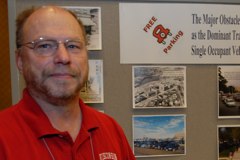
And then I met Charles Weeth from LaCrosse, Wisconsin. Charles is a neighborhood activist turned advocate (he works with Wisconsin Walks, a group that promotes walking as transportation). Charles’ mission is to educate people about the negative impacts of free parking. His poster was titled, The Major Obstacle to Increasing Biking and Walking as the Dominant Transit Choice: Free Parking for Single Occupancy Vehicles (SOVs).
Charles watched says poor parking management and too much free parking is “killing neighborhoods” and that the decisions that lead to this poor management are “based on outdated zoning requirements.” He wants more municipalities to charge fair market rates for parking. Charles told me about research by parking guru Donald Shoup that says 30% of people will change their parking behavior if they have to pay for it.
Around the corner from Charles a group of people were having a spirited discussion about the research presented by Ann Freiwald (also from Wisconsin). Ann’s study — Traffic Fatalities and Debt to Society: Who Pays More? — examined three years of fatal traffic crashes in Madison, Wisconsin and then looked at the outcomes of the civil and criminal punishments (if any).
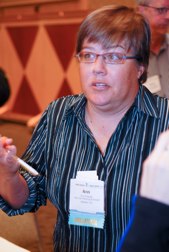
Her expectation was that drivers who killed a pedestrian or cyclists would have generally received less punishment; but what she found was a bit unexpected. Here’s the excerpt from her conclusion:
“I found that killing someone with your car often does not result in criminal charges regardless of how the victim was traveling.
In the few cases (17%) where criminal charges were brought, the sentences range from 8-10 years…
…So many people are breaking the law and driving recklessly that there appears to be little public desire to hold drivers accountable for their behavior even when they kill someone.”
Along with her depressing conclusion she shared a call to action; “Additional data needs to be collected and this information needs to be brought to public attention.”
On a lighter note, I came across an interesting invention; the Speed Vest. Conceived by Brady Clark, and engineered by Portlander Mykle Hansen, the Speed Vest displays your current speed in bright numbers on your back as your ride. Not sure what real safety benefit or real purpose this thing has, but it’s certainly eye-catching (which I guess is the whole point).
Then I bumped into Jeff Smith from the Portland Office of Transportation. Jeff was glowing about this cool T-shirt he got from Dero Bike Rack Company (one of the exhibitors here at the conference). Check it out:
After chatting with Jeff, I turned around to see PDOT’s entry into the transporation science fair: Please Remove my Parking: Portland’s Experience with On-street Bicycle Parking.
The poster included an explanation of our “bike corrals” (which I’ve covered thoroughly over the years) and also had a few drawings of new design concepts they’re considering for the next generation of bike corrals (read about their design issues here).
Among the new design improvements they mentioned (it’s ironic that I have to come to Seattle to get the scoop on something from Portland) are:
- innovative surface treatments, “…an opportunity to play with color, textures, permeability and signage options”;
- stormwater management, “…designs currently used to harness stormwater are being modified to incorporate bicycle parking”;
- business district applications, “…to better fit in with the urban streetscape”;
- and improving accessibility, “…”changes to the spatial layout and the identification of special entrance and exit points…”
PDOT is pouring a lot of thought and staff resources into their next generation of on-street bike parking; I can’t wait to see what they come up with and I am eager to see them tackle the backlog for bike parking that currently exists.
I hope you enjoyed your tour of the Science Fair for Transportation Wonks from Pro Walk/Pro Bike!
— See all of my photos from the Poster Session here.
— For a look at all my conference photos (99 images), check out my 2008 Pro Walk/Pro Bike photo gallery.
[Up next: I have a few more posts from the conference I hope to share including some notes from a presentation given by a TriMet rep on “Bikes and Transit”, a closer look at the Cascade Bike Club, and some thoughts on riding around Seattle. In a few minutes, Congressman James Oberstar will speak at the Closing Plenary and I don’t want to miss that. Stay tuned for photos and coverage of Oberstar’s speech.]



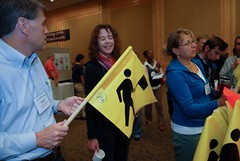
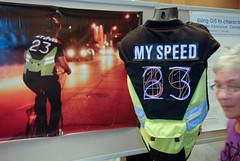
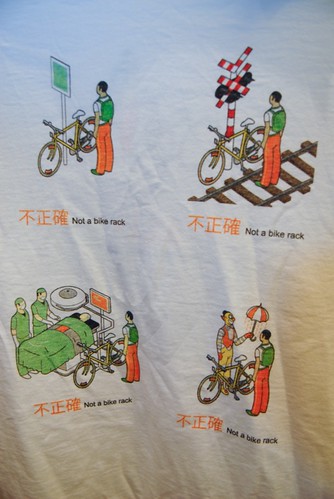
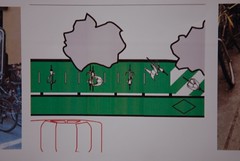
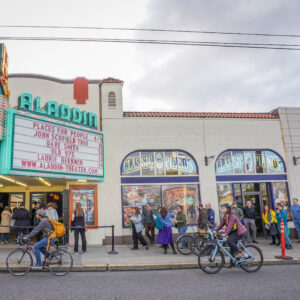
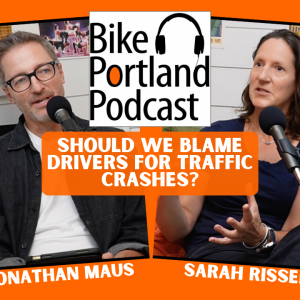
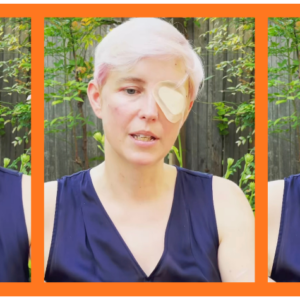
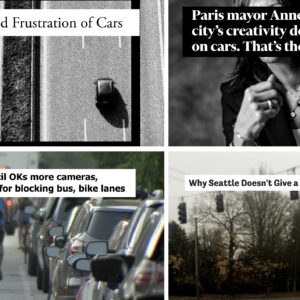
Thanks for reading.
BikePortland has served this community with independent community journalism since 2005. We rely on subscriptions from readers like you to survive. Your financial support is vital in keeping this valuable resource alive and well.
Please subscribe today to strengthen and expand our work.
I\’ll tell you the benefit of the speed safety vest:
In may, I was in a collision with a car that ran a red to make a right turn while I was going through on a fresh green. One of *his* witnesses said *I* was speeding even if I had the green. This was downtown and after coming off a full stop on the previous intersection and traveling a block on 4th St.
Despite me explaining to my adjusters the physical impossibilities of me even *approaching* 20 MPH in that distance with a 1993 mt. bike and loaded panniers, let alone exceeding it, they said he was a \”very credible witness\” with no reason to lie. (his reason to lie was that he showed many signs of being biased toward bikes downtown altogether, but never mind that).
My witnesses that said they didn\’t know if I was speeding. If I was wearing the vest, they would have known I wasn\’t. 😉
Addressing the situation Ann Freiwald has documented is the single most important issue for making people feel comfortable riding their bicycle on the road.
The poster session was very interesting with a ton of variety.
I got a lot of interest in the City of Portland\’s Women on Bikes program. Seems it has been an inspiration to other cities! Yea.
Thanks for covering the conference Jonathan.
Cheers, Janis
The speed vest could be used as evidence that cyclists are running stop signs or red lights.
More importantly it is an example of the desire and need for clothing that that makes cyclists more visible. I\’m continually shocked at the lack of reflective material on most bicycling clothing.